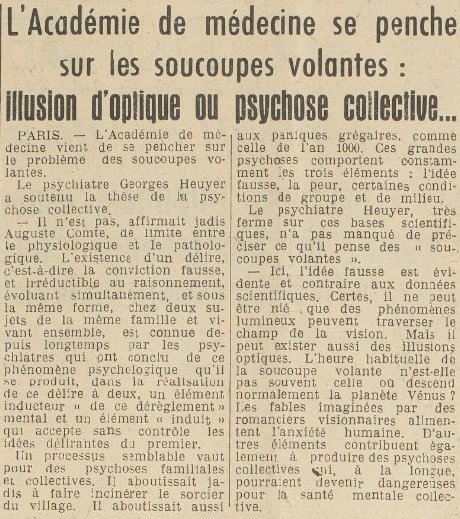The article below was published in the daily newspaper Le Courrier de Saône-et-Loire, France, page 5, on November 18, 1954.

|
PARIS. -- The Academy of Medicine has just turned its attention to the issue of flying saucers.
Psychiatrist George Heuyer defended the theory of mass psychosis.
– "There is no boundary," asserted Auguste Comte long ago, "between the physiological and the pathological. The existence of a delusion - that is, a false belief, impervious to reasoning, developing simultaneously and in the same form in two individuals of the same family living together - has long been known to psychiatrists. From these psychological phenomena, they have concluded that in the realization of this shared delusion, there exists an inducing element - the one causing the mental disturbance - and an induced element, who accepts the delusional ideas of the first without question."
A similar process applies to family and collective psychoses. In the past, it led to the burning of the village sorcerer. It also led to mass panics, like that of the year 1000. These large-scale psychoses always contain three elements: the false idea, fear, and certain group and environmental conditions.
Psychiatrist Heuyer, firmly grounded in his scientific principles, did not fail to clarify his thoughts on "flying saucers."
– "Here, the false idea is obvious and contradicts scientific facts. Certainly, it cannot be denied that luminous phenomena can cross the field of vision. But optical illusions can also occur. Isn't the usual hour of flying saucer sightings often the same as when the planet Venus normally appears? The fables imagined by visionary novelists feed human anxiety. Other factors also contribute to creating collective psychoses which, in the long run, could become dangerous for collective mental health."
I am not going to "debunk" the entirety of Georges Heuyer's statements presented here - they are probably very poorly reported.
Two remarks, however:
Heuyer refers to Auguste Comte.
Auguste Comte (1798–1857), a teacher of mathematics and astronomy, was the originator of "positivism", which initially aimed to combat metaphysics - too abstract and vague - as well as theology and belief systems. He also defended the idea that the science of his time - Newtonian physics - already knew everything there was to know, aside from a few unimportant details. Unfortunately, he also believed that public beliefs regarding science should be strictly regulated and monitored by an established body composed of men deemed competent and armed with all the rigor of secular authority...
By 1954, after Einstein's work on relativity and the birth of quantum physics - both emerging from those famous "unimportant details" - it should have been clear to Heuyer that science was far from "complete," and that dogmatism is not at all productive.
Heuyer claims that the "usual hour of the flying saucer" is often "when the planet Venus normally sets." This argument is monumentally foolish. Do I even need to point out that Venus does not set at the same time every day? This is the kind of blunder committed by those who think that "psychology" is the only valid science to approach the issue. Not at all; even so-called "optical illusions" (mirages, halos...) are not truly "illusions" and are not understood because "psychology" explains them - they are generally explained by physics. What psychology brings, when properly understood, is the need to distinguish between interpretation and description. For example, in 1954, there were frequent descriptions of obvious meteors - recognizable by their features - which were often called "crafts," which is a matter of interpretation.
Heuyer's "great concern" was that a "flying saucer" was sometimes reported by numerous witnesses. A single witness did not trouble Heuyer: it had to be the delusion of a poorly wired brain. But the famous "collective hallucination" left some people rather skeptical - and rightly so. He thus revisited the idea of "shared madness" (folie à deux), extended it to more than two people, and ultimately turned it into "mass psychosis," which for him was the solution to the flying saucer question.